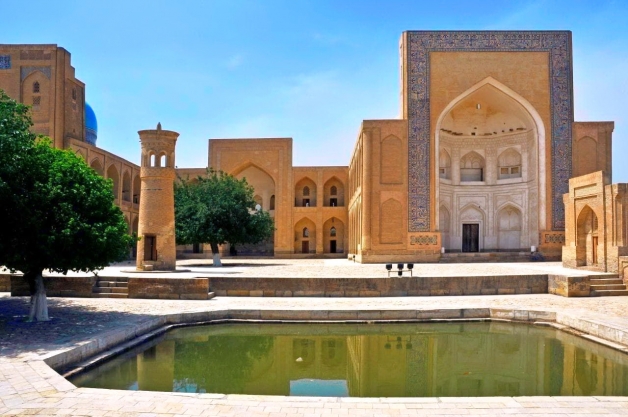The Memorial Complex of Chor-Bakr, Bukhara (suburb)
They were true kings because no decision was made without their consent, and they had much more power than nominal rulers.
The village of Juybar, where the famous Juybar Seyids come from (descendants of a noble family of the Prophet Muhammad), was a rabad, a suburb of Bukhara, 5 km from the regional center. It was a huge settlement, and when Bukhara brought it within its borders, beyond the fortress wall, many quarters were formed out of it.
The sheikhs were followers of the Naqshbandi Sufi order, famous preachers, and scholars of Islam. They were also significant feudal lords who owned land and entire towns. The Khan of Bukhara, Abdullah Khan, the son of Sultan Iskander, saw in the person of the first Juybar Khoja Muhammad Islam his mentor and teacher. Khoja Islam was an adviser to the sovereign in major and minor matters, and he was honored on a par with the Khan. Abdullah Khan once dared to decide without Khoja Islam and agreed to the proposal to move the capital from Bukhara to Balkh. Hodja Islam, hearing the news, humbly said that the decision was made without consultation and let's see what will come out of it... Needless to say, Abdullah Khan, learning about these gentle but full of meaning words of his mentor changed his mind immediately.
And there was much to be afraid of. Khoja Islam had the power to remove rulers and appoint others according to his will and desire, and his power was unlimited. At the same time, the seyids of Juybar had authority among the people; they were scholars, poets, clerics, diplomats, and ambassadors. The eldest son of Khoja Islam, Khoja Saad was not only an "uncrowned ruler" and the richest man but also a benefactor and builder who facilitated the construction of many religious and civil buildings, madrasahs with khanqahs (khanakas), bathhouses with bazaars, sardobas (public wells), and workshops. Khoja Saad was the kind of politician who thought first and foremost of the prosperity of the state, for "what honor is there in ruling a poor and hungry people?"
The Chor Bakr Necropolis, Bukhara (a suburb) was originally conceived unconventionally as a garden with a mosque, khanaka, and madrasah in the middle - all above the tomb of Khoja's ancestor Abu Bakr Saad. The architectural ensemble was erected in the shortest possible time of only three years, completing construction in 1563. Poplars, cypresses, plane trees, and pines were planted around it, and a road from the Bukhara Gate was paved. It was a charming place, Khan himself often rested in these gardens, and the students of the madrasah, with pencils and thick books, used to walk along the stone paths. In the 20th century, a small minaret was built in the middle of the square, like any Bukhara minaret, repeating the shape and lantern of the Kalyan Minaret
Khoja Islam died and was buried in three shrouds of brocades inside the tomb of his ancestor. Later, Abu Bakr Fazl and Tojiddin Hasan were buried in this tomb (khazira) too. This was the beginning of the necropolis and the family tomb of the Juybar seyids. Four representatives of the family, "four brothers" is how the name of the Chor Bakr complex is translated. Now the number of facilities on the territory of the complex exceeds 30.
Even though the Juybar Khoja were Muslim and Sufi, near some of the graves you can see Zoroastrian lanterns, small cylindrical structures with a niche in the middle, for lighting the fire. Traces of ancient majolica and high stone bases remain as well. And also on the graves grows a very strange tree - a chulon, which in ancient times was called the "breaker of evil spirits". Its trunk is pitted like an old wall with very sharp thorns-seeds growing among its leaves. And it gives a whimsical shadow that lays in a mysterious calligraphic ligature on ancient graves.
Time has not spared the terracotta necropolis, but even restored, raised from the ruins, it makes an impression. Bukhara history teachers like to hold their lessons on the Sheibanid period in it. Silent, austere, and lofty "City of the Dead Kings", with its many alleys, tombs, doors, and passages - this is a real place for meditation. Here you will not see a stream of tourists or many pilgrims - the necropolis is quiet, and only the sound of loose doors under the locks breaks the silence.









